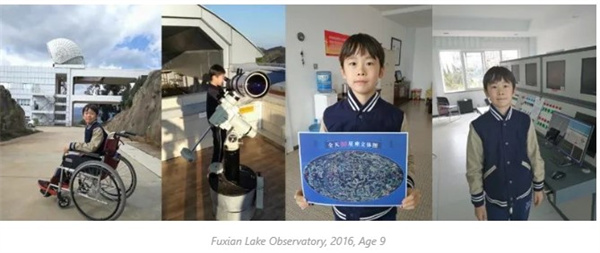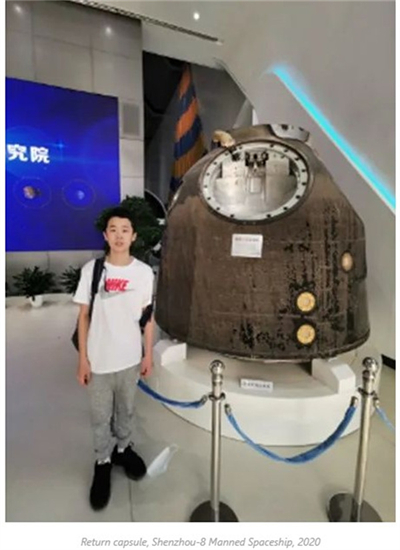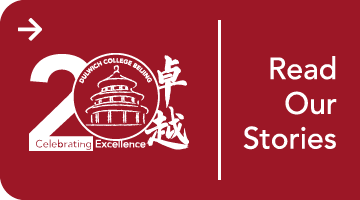DCB’s Daniel Z is Youngest Author in Chinese National Astronomy
Dulwich College Beijing is proud to share that our Year 10 student Daniel Z is now the youngest lead author of a study published in the nationally renowned Chinese National Astronomy magazine!

His submission, Universe Panorama: An Audio-Visual Feast of Multi-Band Galaxy World, is also on the cover page of this prestigious journal. The Chinese National Astronomy magazine is sponsored by the Chinese Academy of Sciences and China's National Observatory and publishes the latest discoveries and developments in Astronomy in China. It is also currently the most authoritative publication on Astronomy in China, having won awards such as the "2019 China Top Ten Popular ScienceSelf-media", "2020 China Excellent Popular Science Journal", "China Science Popularization Expo Most Quality Media Partner", "Sina 2019 Best Science Communication Media Award" and other awards and honours issued by the China Association for Science and Technology.

In this piece, we learn more about our young astronomy enthusiast, more about the Universe Panorama: An Audio-Visual Feast of Multi-Band Galaxy World, his journey from observer to researcher and now published author, and his advice for budding astronomy enthusiasts.

What sparked your interest in astronomy?
I’ve had a strong interest in aerospace and astronomy since I was six, as the vast and mysterious universe have always fascinated me. I love reading books about humans’ exploration of the unknown space as well as periodicals to keep up with the latest developments in astronomy.

What inspired you to work on this Science Paper?
In 2016, I made my first trip to Xinglong Observatory in Hebei Province and was fascinated by the Large Sky Area Multi-Object Fiber Spectroscopy Telescope (LAMOST), or Guo-Shoujing Telescope –named after a respected Chinese ancient astronomer. This telescope is a world leader in large-scale optical spectral observation and wide field of view astronomical research.

I was 9 at the time, and I can't remember specifically how much astronomical knowledge I had learned during that visit, but every scene about that telescope is still fresh in my mind. Afterwards, I began to search for information about LAMOST and made up my mind to go and see every famous telescope in China.

In the past six years, I have visited or practiced in most of China’s key observatories, some of which I have visited several times. There I experienced and studied the most reputed astronomical telescopes in China. I focused on Celestial Radiation and Multi-Band Astronomy, and later I summarised my studies and findings in my paper titled Celestial Radiation and Astronomical Telescopes.

During my latest visit to the (Five-hundred-meter Aperture Spherical Radio Telescope) FAST, I learned that a lot of FAST data is open to the public. I came to the idea that it is possible to obtain the FAST observation information of a galaxy in the radio band and compare them with the same galaxy imaging obtained by optical telescopes, which may lead to unexpected results.

After I returned from this trip, I conducted imaging observations of two galaxies and compared their visible light band with the radio band. By combining the observation and analysis results with the knowledge of celestial radiation and multi-band astronomy, I completed a popular science paper which was published in the journal of “Chinese National Astronomy” with the title “Universe Panorama – Audio-visual feast of multi-band galaxy world”. I am the first ever high school student author of this national astronomy journal.

Tell us more about your paper and its journey to the Chinese National Astronomy journal.
During my practice and observation these past few years, Director Bai and his colleagues at the Yunnan Observatory helped me a lot. He encouraged me to write my first popular Science paper Celestial Radiation and Astronomical Telescopes, which summarised my knowledge and research in multi-band astronomy and telescopes over the past few years. I didn't mean to publish it until this summer after conducting imaging observations of the same galaxy and comparing its visible and radio wavelengths, forming a new image by combining telescope data from radio and visible wavelengths.

Director Bai told me that the value of an article did not lie in the amount of knowledge it contained, but in its novel ideas or innovative practices. He encouraged me to submit it to Chinese National Astronomy, which pays special attention to novel practical observation work. I am also very grateful to my co-author Mr. Yun Zheng, who specialises in the study of 21-centimeter neutral hydrogen and was responsible for the processing and imaging of radio-band galaxy data in the paper.

We’ve also heard that you participated in the ‘Payload Solicitation Program for Chang’e-7 Lunar Exploration Mission’. Could you tell us more about that?

The Payload Solicitation program was an astronomical science activity hosted by China National Space Administration for the Chang’e-7 Lunar Exploration Mission, which is scheduled to launch in 2026. Sponsored by China National Children's Center, I formed a research team with a group of astronomy enthusiasts my age. After nearly a year and a half, we submitted our proposal Payload of Cosmic Ray Protective Material Experiment in Lunar Surface Environment, which is to design experimental equipment which will be carried by the Chang'e-7 lunar probe to test the effectiveness of protective materials against cosmic rays on the moon surface.
Our proposal was selected as one of the 27 shortlisted plans from 203 submissions nationwide and received 140,000 votes in the ensuing online voting procedure, ranking 12th. Finally, it passed the panel review and even won an Award of Excellence!

This activity greatly enhanced my ability to compile science papers, my hands-on ability as well as teamwork and overall planning capabilities, and more than that, I gained insights into the developments of China’s lunar exploration program. As this was the most professional competition I have been to, it opened my eyes to how there are so many other young talents in the world. Collaboration was proven to be more useful than personal skill in this event, and through effective communication, our team managed to achieve an impressive result.
What’s next for you?
My next target is Lenghu (cold lake) region, located on the edge of Qaidam Basin in Qinghai Province, which is one of the high-quality observation sites on the Earth's surface. The climate there is extremely dry, and the local sky is exceptionally clear.
The world’s largest sky survey telescope LAMOST is scheduled to move to Lenghu next year. I would like to visit the new LAMOST in Lenghu to deepen my understanding of the high-precision and high-resolution sky survey.

Lenghu is also known as "the most Mars-like place on Earth". I’m also planning to go to Lenghu Mars Camp. Last year, I participated in the Pursue Our Mars Dream program hosted by the China National Space Administration (CNSA). I hope to learn more about Mars exploration.
The study of astronomy is not only my passion, but also enhances my academic research ability and opens up space for me to explore the unknown world. I will continue my astronomy research through my high school and college in the coming years.

Any tips for budding astronomers everywhere who want to get into astronomy?
I highly recommend reading “Chinese National Astronomy” and the Beijing Planetarium’s “Amateur Astronomer.”
I also strongly recommend going out and visiting the observatories. I have visited the FAST twice, and each time I met many middle school amateur astronomers. They flew to Guiyang and then drove 2 hours to visit the China Sky Eye (another name for the FAST). When you see the 500-meter diameter radio telescope, you will feel the trip is worthwhile and – if you really love astronomy – I think your passion for astronomy will start to burn at this moment.


Congratulations Daniel Z on getting your first Scientific Paper published in this prestigious journal, and to his teachers and his family for this amazing achievement!
Below is a translated version of Daniel Z’s work:
Universe Panorama: An Audio-Visual Feast of Multi-BandGalaxy World. Translation by Daniel
This interview has been condensed for brevity and clarity. All photos were submitted by Daniel Z.








